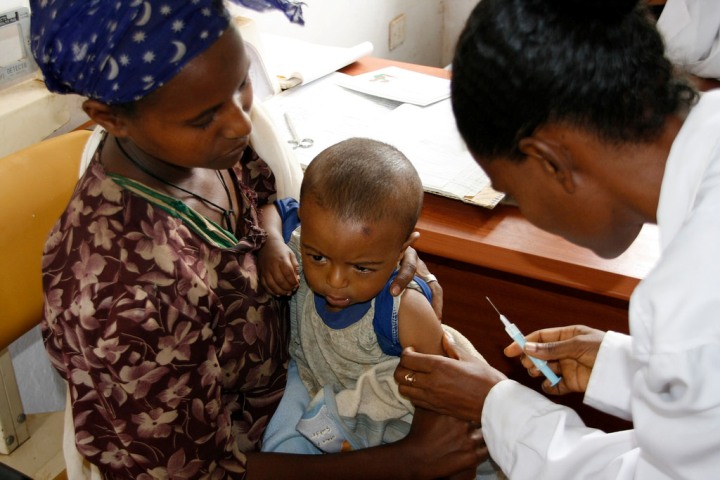Ethiopia Vaccinates Over 18.5 Million Children in 2025 Measles Drive
Dr. Owen L. Kaluwa, WHO Representative to Ethiopia, praised the Ethiopian government for its strong leadership, coordination, and community engagement.

- Country:
- Ethiopia
Ethiopia has successfully concluded its 2025 nationwide integrated measles vaccination campaign, reaching a remarkable 18,570,244 children—an impressive 99% of the targeted population. The ten-day initiative, which commenced on 14 May 2025, spanned all 12 regions of the country, with the Somali Region and Addis Ababa City Administration launching their activities slightly later, on 21 May and 26 May, respectively.
The campaign stands as one of Ethiopia’s largest and most coordinated public health initiatives in recent years, targeting children aged 9 to 59 months to protect them against measles—a highly contagious and potentially fatal disease that continues to threaten vulnerable populations, particularly in areas with low routine immunization coverage.
Bishoftu Launch: A Symbol of National Unity and Commitment
The official national launch was held in Bishoftu, Oromia Region, and organized in collaboration with the World Health Organization (WHO) under the leadership of the Ministry of Health (MoH). The event brought together national and regional leaders, health officials, civil society partners, and local community representatives in a strong demonstration of Ethiopia’s commitment to child health and disease prevention.
Dr. Owen L. Kaluwa, WHO Representative to Ethiopia, praised the Ethiopian government for its strong leadership, coordination, and community engagement. “I would like to congratulate and commend the Ministry of Health for your leadership and effort undertaken to realize the successful implementation of the 2025 National Integrated Measles Supplementary Immunization (SIA) Campaign,” he said.
Dr. Kaluwa reaffirmed WHO’s commitment to continue supporting Ethiopia in strengthening routine immunization and primary health care systems to reduce child mortality and advance universal health coverage.
Integrated Health Interventions: A Holistic Approach to Child Welfare
More than just a vaccination campaign, the 2025 Measles SIA was part of an integrated health service package. The campaign provided a platform to reach children and families with a comprehensive set of interventions, ensuring efficient resource use and maximizing health impact:
-
Routine Immunization:
-
191,346 zero-dose children received their first vaccines.
-
211,546 under-vaccinated children were brought up to date on routine immunizations.
-
-
Nutritional Screening:
-
Over 18.9 million children under five were screened.
-
874,722 children were found to be moderately acutely malnourished (MAM).
-
122,207 children were diagnosed with severe acute malnutrition (SAM) and referred for treatment.
-
-
Vitamin A Supplementation:
-
More than 15 million children received Vitamin A, a critical micronutrient for immunity and vision.
-
-
Deworming:
-
11,095,948 children aged 24–59 months were administered albendazole, an antiparasitic treatment.
-
-
COVID-19 Vaccination:
-
206,431 Pfizer doses were delivered to high-priority groups, reinforcing pandemic preparedness efforts.
-
-
Obstetric Fistula Identification:
-
1,325 suspected cases of obstetric fistula were identified and referred for specialized care.
-
-
Sick Child Referral:
-
Over 49,312 children presenting symptoms of illness were referred to appropriate health facilities.
-
Partners, Communities, and Media Play a Vital Role
The successful implementation of the campaign was made possible through close collaboration between government agencies, international health partners, civil society, and grassroots community organizations. WHO played a central role, providing technical and financial support throughout all stages of the campaign—from proposal development and microplanning to training, supervision, and national coordination.
The media’s contribution in creating public awareness was also pivotal. Through targeted messaging, community outreach, and multilingual content dissemination, media outlets helped generate trust and demand for vaccinations, particularly in remote and underserved regions.
A Model for Future Public Health Campaigns
The campaign’s success underscores the power of multi-sectoral coordination, political will, and community ownership in delivering life-saving services. It also demonstrates how large-scale vaccination drives can serve as vehicles for wider public health interventions, including malnutrition screening, deworming, and maternal health surveillance.
This integrated model aligns with WHO’s global guidance on strengthening health systems and building resilient services that leave no one behind.
Looking Ahead: Sustaining Gains in Routine Immunization
While the campaign closed critical immunity gaps, the Ministry of Health, in partnership with WHO and other stakeholders, is now focusing on consolidating gains through routine immunization. Strengthening health information systems, enhancing cold chain infrastructure, improving vaccine accessibility, and training community health workers remain priorities for 2025 and beyond.
WHO reiterated its long-term commitment to supporting Ethiopia in achieving its immunization and child health goals.
Ethiopia’s 2025 integrated measles campaign is a landmark achievement in public health, reaching nearly every targeted child across the country in a coordinated effort to protect future generations. As the country builds on this momentum, the campaign offers a replicable model for integrated health delivery and reinforces Ethiopia’s commitment to Universal Health Coverage and the Sustainable Development Goals (SDGs).
ALSO READ
Child Malnutrition Crisis in Afghanistan Worsens Amid Aid Cuts
Grappling with Global Health: From Bird Flu Bans to Malnutrition in Gaza
Decoding Health: DNA Insights, Weight Loss Trends, and Global Malnutrition
Gaza: Acute malnutrition among children hits record high
Gaza: Guterres urges probe into killing of journalists, as child malnutrition deaths rise










